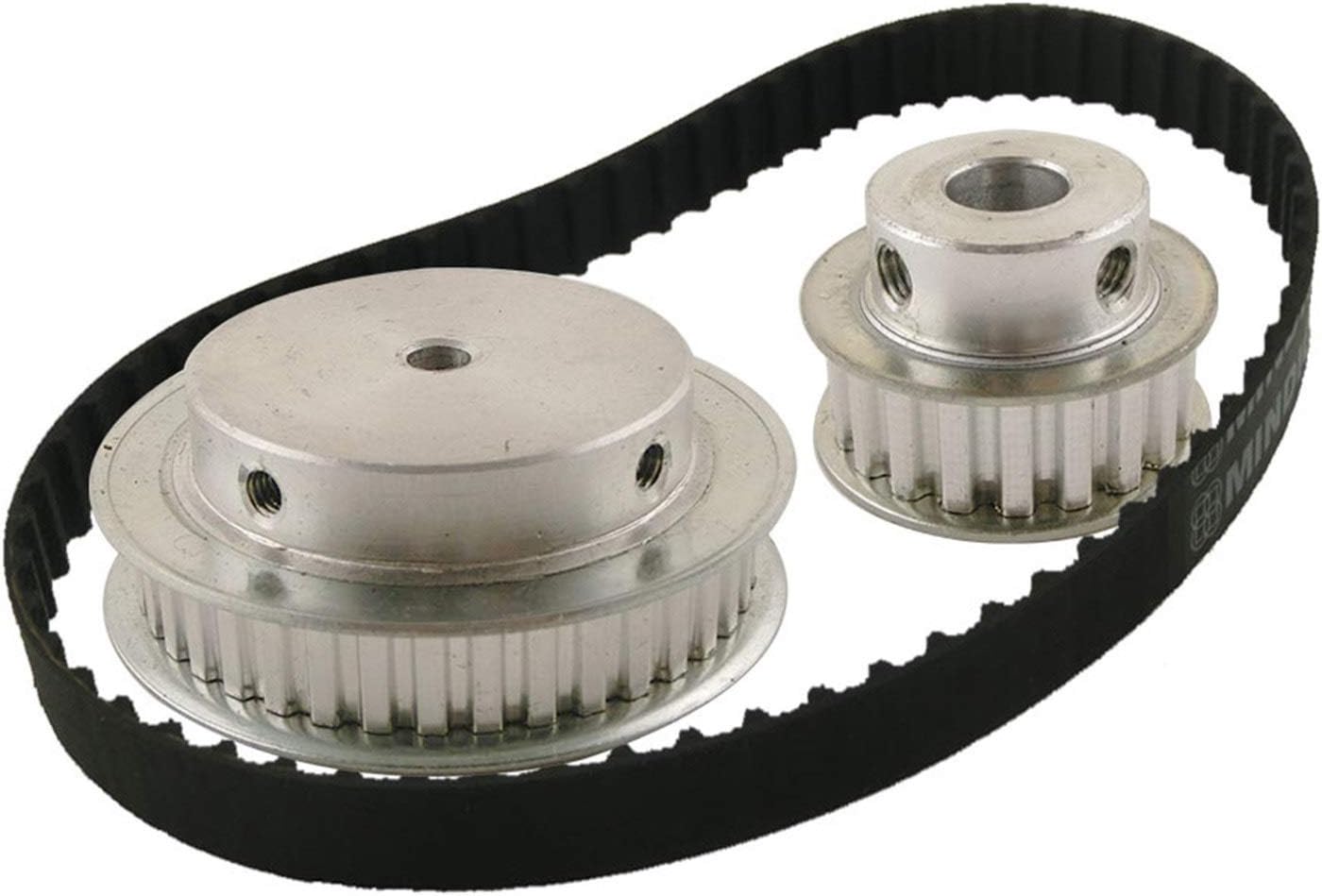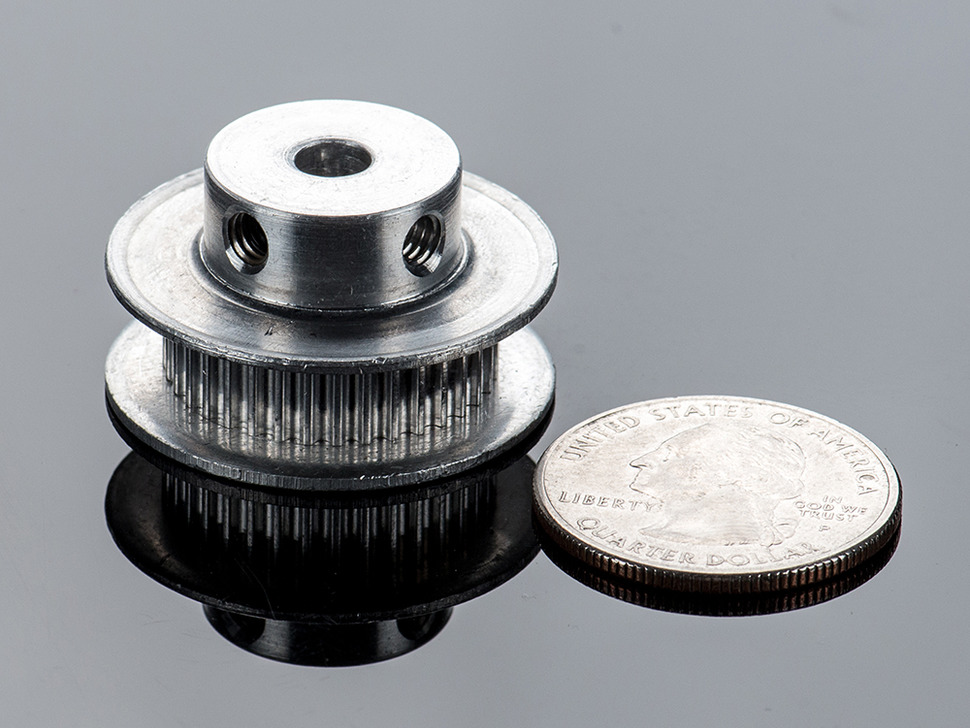Product Description
Product Description
Aluminum/C45 Timing Belt Pulley
| Product Name | Aluminium Timing Pulley MXL XL L H XH XXH T2.5 T5 T10 AT5 AT10 S2M S3M S5M S8M GT2 GT3 GT5 3M 5M 8M Tooth timing Belt Pulley | |
| Teeth profile | Trapezoidal toothed | MXL, XXL, XL, L, H, XH, XXH |
| T-toothed | T2.5, T5, T10, T20 | |
| Arc toothed | HTD3M, HTD5M, HTD8M, HTD14M, HTD20M, Gt2, Gt3, Gt5 | |
| S-toothed | S2M, S3M, S4.5M, S5M, S8M, S14M | |
| Parabolic-toothed | P2M, P3M, P5M, P8M, P14M | |
| Y-toothed | G2M, G3M, G5M, Y8M | |
| Teeth Quantity | 10-150 teeth or customized | |
| Inner Bore | 2-200mm H7 precision or customized | |
| Belt width | 4mm, 6mm, 9mm, 10mm, 12mm, 15mm, 20mm, 25mm, 30mm, 40mm, 50mm, 1/4”, 5/16”, 3/8”, 1/2”, 3/4”, 1”, 1.5”, 2”or customized | |
| Material | carbon steel C45, Aluminum 6061, 6082 | |
| Surface treatment | Anodize,Black Oxide,Phosphate, Galvanization, Nitriding, Dichromate | |
Detailed Photos
Timing pulley used on conveyor roller
Workshop
Equipments:
Lathe machine, Hobbing machine,Drilling machine,CNC machine,Milling machine, etc
FAQ
Q1: Are you trading company or manufacturer ?
A: We are factory.
Q2: How long is your delivery time and shipment?
1.Sample Lead-times: 10-20 days.
2.Production Lead-times: 30-45 days after order confirmed.
Q3: What is your advantages?
1. The most competitive price and good quality.
2. Perfect technical engineers give you the best support.
3. OEM is available.
| Certification: | ISO |
|---|---|
| Pulley Sizes: | Timing Belt Pulley |
| Manufacturing Process: | Hobbing Teeth |
| Material: | Aluminum |
| Surface Treatment: | Anodizing |
| Application: | Chemical Industry, Grain Transport, Mining Transport, Power Plant |
| Customization: |
Available
| Customized Request |
|---|

What is the significance of precision machining in XL pulley manufacturing?
Precision machining plays a crucial role in XL pulley manufacturing, offering several significant benefits. Here is a detailed explanation of the significance of precision machining in XL pulley manufacturing:
1. Accurate Dimensional Control:
Precision machining ensures accurate dimensional control in the manufacturing process of XL pulleys. The precise shaping and machining of the pulleys’ components, such as the hub, bore, and tooth profile, guarantee the correct fit and alignment with other components in the power transmission system. Accurate dimensional control results in smooth and efficient operation of the pulleys.
2. Consistent Tooth Profile:
Precision machining allows for the consistent production of the tooth profile on XL pulleys. The teeth on the pulleys must have precise shapes and dimensions to properly engage with the teeth of the timing belt, ensuring reliable power transmission. Consistency in tooth profile eliminates irregularities or variations that could lead to belt slippage, premature wear, or reduced system efficiency.
3. High Surface Quality:
Precision machining techniques produce XL pulleys with high surface quality. The smooth and polished surfaces of the pulleys reduce friction and wear, contributing to improved efficiency and prolonged belt life. High surface quality also minimizes noise, vibrations, and the risk of debris accumulation, ensuring smooth and reliable operation in various industrial applications.
4. Tight Tolerances:
Precision machining allows for the production of XL pulleys with tight tolerances. Tight tolerances ensure close adherence to specified dimensions and performance requirements. The precise alignment of pulley components, such as the bore and keyway, with the shaft guarantees a secure and accurate fit. Tight tolerances enhance the pulley’s overall performance, reliability, and compatibility with other system components.
5. Customization Capabilities:
Precision machining enables the customization of XL pulleys to meet specific application requirements. Manufacturers can easily modify the pulley’s design, dimensions, or features to tailor it for unique industrial needs. Precision machining techniques facilitate the production of custom pulleys with precise specifications, ensuring optimal performance and compatibility with the intended application.
6. Efficient Production Process:
Precision machining techniques, such as computer numerical control (CNC) machining, offer efficient and automated processes for XL pulley manufacturing. CNC machines can produce pulleys with high accuracy and repeatability, reducing human errors and ensuring consistent quality. The efficient production process enabled by precision machining results in cost-effective manufacturing, shorter lead times, and increased production capacity.
In summary, precision machining is of significant importance in XL pulley manufacturing due to its ability to achieve accurate dimensional control, consistent tooth profile, high surface quality, tight tolerances, customization capabilities, and efficient production processes. These factors contribute to the overall performance, reliability, and compatibility of XL pulleys in various industrial applications.

How do advancements in material technology influence the design of modern XL pulleys?
Advancements in material technology have a significant impact on the design of modern XL pulleys. Here’s a detailed explanation of how these advancements influence their design:
1. Enhanced Durability:
New materials with improved strength and durability allow for the design of XL pulleys that can withstand higher loads, operate at higher speeds, and have increased resistance to wear and fatigue. Advanced materials, such as high-strength alloys, composites, or specialized polymers, provide superior mechanical properties, enabling the design of more robust and long-lasting pulleys.
2. Weight Reduction:
Lightweight materials, such as carbon fiber composites or engineered polymers, contribute to the design of lightweight XL pulleys. Reduced weight in pulley systems offers advantages such as improved energy efficiency, reduced inertia, and lower overall system weight. This is particularly beneficial in applications where weight reduction is critical, such as aerospace, automotive, or portable machinery.
3. Corrosion Resistance:
New materials with excellent corrosion resistance properties, such as stainless steel or corrosion-resistant coatings, enable the design of XL pulleys suitable for harsh or corrosive environments. Corrosion-resistant pulleys are essential in industries such as marine, chemical processing, or outdoor applications where exposure to moisture, chemicals, or saltwater can cause degradation and premature failure.
4. Temperature Resistance:
Advancements in material technology have led to the development of materials that can withstand extreme temperatures. For applications involving high or low temperature environments, such as industrial ovens, furnaces, or cryogenic systems, the use of materials with superior temperature resistance ensures the pulleys maintain their performance and integrity under challenging operating conditions.
5. Noise and Vibration Damping:
New materials with inherent damping properties, such as elastomers or composite laminates, contribute to the design of XL pulleys that can effectively reduce noise and vibrations during operation. This is particularly important in applications that require low noise levels or where excessive vibrations can affect the performance and reliability of the system.
6. Customization and Flexibility:
Advancements in material technology provide designers with a wider range of options to tailor the properties of XL pulleys to specific application requirements. Materials can be formulated or engineered to meet specific needs such as high friction coefficients, electrical conductivity, or resistance to specific chemicals. This customization and flexibility in material selection allow for the optimization of pulley design and performance for various applications.
Overall, advancements in material technology have revolutionized the design of modern XL pulleys by offering improved durability, reduced weight, corrosion resistance, temperature resistance, noise and vibration damping, and customization options. Manufacturers can leverage these advancements to develop pulleys that meet the evolving needs of diverse industries and deliver enhanced performance and reliability.

Can you explain the key characteristics and specifications of XL pulleys?
XL pulleys have specific characteristics and specifications that are important to understand for their proper selection and use. Here are the key details:
1. Tooth Profile:
XL pulleys have a tooth profile designed to work with XL timing belts. The tooth profile is trapezoidal in shape, with specific dimensions and angles to ensure precise engagement with the corresponding teeth on the timing belt.
2. Pitch Size:
The pitch size of an XL pulley refers to the distance between adjacent tooth centers. XL pulleys have a standardized pitch size of 0.200 inches (5.08 mm). This pitch size ensures compatibility with XL timing belts of the same pitch, allowing for easy interchangeability.
3. Belt Width Compatibility:
XL pulleys are designed to accommodate XL timing belts of specific widths. The belt width is determined by the application requirements and load considerations. XL pulleys are available in various groove widths to match the corresponding XL timing belt width, ensuring proper belt engagement and power transmission.
4. Material and Construction:
XL pulleys are commonly made from materials such as aluminum, steel, or plastic. The choice of material depends on factors like the application requirements, load capacity, and cost considerations. The pulleys are precision-machined to ensure accurate tooth profiles, smooth operation, and reliable performance.
5. Number of Teeth:
The number of teeth on an XL pulley determines the speed ratio and the positioning accuracy of the motion control system. The number of teeth can vary depending on the specific application requirements and the desired speed and torque ratios.
6. Flange Options:
XL pulleys may come with flanges on one or both sides. Flanges provide additional support to the timing belt, preventing it from slipping off the pulley during operation. The presence and configuration of flanges depend on the specific application needs and the desired level of belt stability.
7. Application Range:
XL pulleys are suitable for applications that require precise motion control, such as robotics, CNC machines, 3D printers, and other automated systems. They can handle moderate to high torque requirements and operate at various speeds, depending on the specific pulley size, material, and construction.
8. Interchangeability:
Due to standardized pitch sizes and tooth profiles, XL pulleys from different manufacturers are interchangeable with XL timing belts of the same specifications. This interchangeability simplifies replacement, maintenance, and system upgrades.
Understanding these key characteristics and specifications of XL pulleys is essential for selecting the right pulley for a given application, ensuring proper power transmission, and achieving accurate motion control.


editor by CX
2023-11-20
